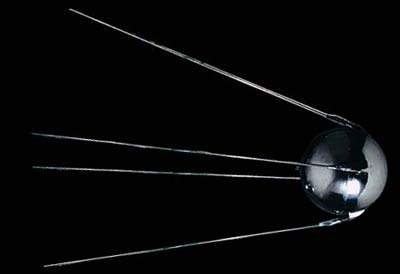4 Outubro
O dia 4 de Outubro marca o começo da Semana do Espaço… e há uma boa razão para isso, claro. No já longínquo ano de 1957 foi neste dia que a então URSS procedeu ao lançamento do que se tornou o primeiro satélite artificial da Terra, o Sputnik 1. Estava-se em pleno Ano Geofísico Internacional, e ambas as superpotências tinham anunciado, anos antes, que tencionavam lançar satélites artificiais nessa ocasião.
Não foi um momento que surgiu do nada. A Humanidade já tinha enviado objectos para lá da atmosfera, mas nunca se tinha tentado que eles entrassem em órbita terrestre. Por outro lado, vivia-se a Guerra Fria, e a competição entre os dois blocos estava ao rubro. O espaço era visto como um novo e importante campo para obter vantagens sobre o inimigo, incluindo militares.

O primeiro satélite não tinha a bordo instrumentos científicos – na realidade, o Sputnik 1 surgiu quase como recurso, já que o satélite inicialmente previsto para inaugurar a Era Espacial era bastante mais complexo… e atrasou-se. Levava dois transmissores, responsáveis pelo famoso ‘bip-bip’ emitido pelo satélite e escutado por todo o mundo. Era basicamente uma esfera de alumínio de 58 cm de diâmetro com quatro longas antenas acopladas, que pesava quase 84 kg. Levava pouco mais de hora e meia a realizar uma órbita com inclinação de 65 graus. O satélite funcionou durante 21 dias, e regressou à atmosfera terrestre e foi destruído a 4 de Janeiro de 1958.
4 October marks the beginning of Space Week… and there’s a good reason for that, of course. In the already distant year of 1957, it was on this day that the then USSR launched what became the first artificial satellite of the Earth, Sputnik 1. The International Geophysical Year had begun, and both superpowers had declared, some years earlier, that on the occasion they intended to launch artificial satellites.
This didn’t come out of thin air. Humankind had already launched objects that had left the atmosphere, but no one had ever tried to put them into orbit. On the other hand, the Cold War was very much alive, and competition between the two blocks was at its height. Space was seen as a new and important field to gain advantages, including of the military kind, over the enemy.

The first satellite had no scientific instruments on board – in fact, Sputnik 1 was developed almost as a quick fix, given that the satellite that was originally planned to inaugurate the Space Age was rather more complex… and behind schedule. It carried two transmitters, responsible by the famous ‘beep-beep’ that the satellite emitted and was heard all over the world. It was basically an aluminium sphere with a diameter of 58 cm, with four long antennas, weighing almost 84 kg. It took little more than a hour and a half to complete one orbit, with an inclination of 65 degrees. The satellite worked for 21 days, and it reentered the Earth’s atmosphere and was destroyed on 4 January 1958.


Leave a Reply